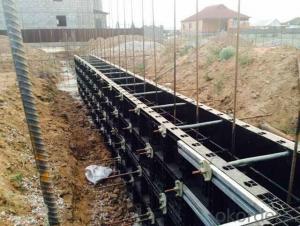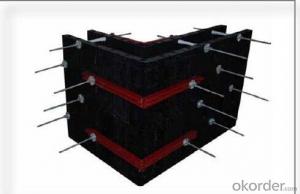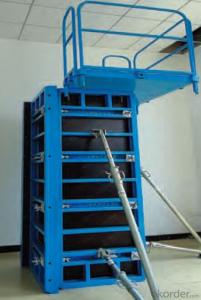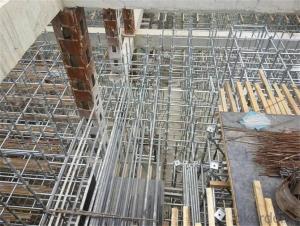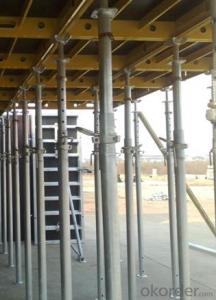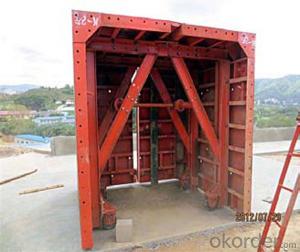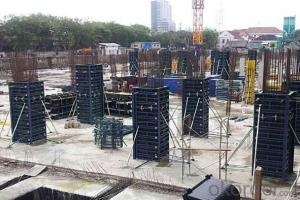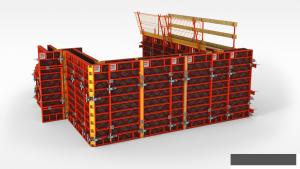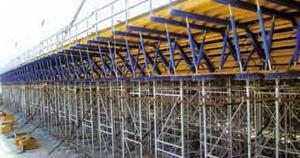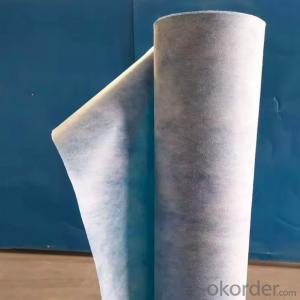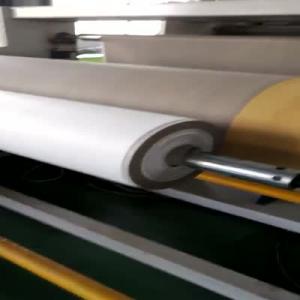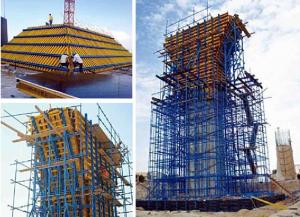easy-set-up plastic formworks used in buildings
- Loading Port:
- Tianjin
- Payment Terms:
- TT OR LC
- Min Order Qty:
- 1 m²
- Supply Capability:
- 100000 m²/month
OKorder Service Pledge
OKorder Financial Service
You Might Also Like
1. Main Introduction of Cup-lock Scaffolding:
The biggest panel is 120x60cm, weight only 10.5kg, which can be lift and set up by only one person easily, need no crane on the site.
2. TheAdvantages of Cup-lock Scaffolding:
-easy set up
Different size of panels can be firmly locked by simply turn the special handles to 90 degree. The panels have rib on the back, which makes the
system need not traditional wood blocks and nails. The panels have holes to fit tie rod, guarantee the strength of the whole system.
-modularity
Modular formwork composed by different size of panels, the main item is 120x60 panel, the size is 120x60cm, which used for the large area of walls
and slabs. There are also small size of panels like 10x60 panel (10x60cm), 20x60 panel (20x60cm), 25x60 panel (25x60cm), inner corner (20x20x60cm) and outer corner (10x5x60cm). Due to the variety of panel size, the system can form almost all size walls120x60 panel (act size 120x60cm) of multiple by 5cm. The material of modular formwork is PC-ABS mixied with special glass fibres which enable panels to hold high pressures.
-strength
The handles are made by high strength Nilon, each panel locked by at least 4 handls, which makes the whole system strong enough to pour 40cm walls.
-enviroment friendly
The system need not cut and nail due to the variety size, and nearly need no wood, the material can be recycled after broken, will not pollute the enviroment.
-consequent
Concrete does not stick to plastic, thus the panels need no oil before using, and can be cleaned simply by water. The surface of the wall which built by modular formwork is smooth, can be left without rework.
3. Images for Plastic formwork:
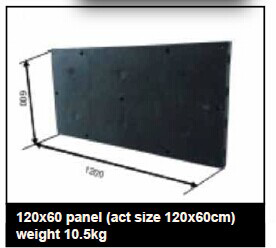
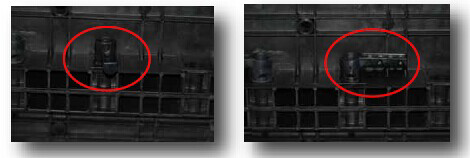
4. FAQ of Plastic concrete formwork
1) What can we do for you?
We can ensure the quality of the vinyl banner and avoid extra expenses for customers.
.We can provide you the professional design team.
.We can provide fashionable and newest styles for you.
.We can design the artwork for you.
. Please feel free to customize.
2) What promises can be done by us?
. If interested in plastic formwork, please feel free to write us for any QUOTE.
. If printing required, please advise asap because the whole set need much more time to complete.
. Please DO check goods when courier knocks your door and contact us asap if any issue.
3) What about of our after-sale service?
. Response will be carried out in 24hours after receiving any complain or request.
. Frame-Connected Scaffolding cost can be refund after order is confirmed.
. If the products are not based on the requirements, there will be the relevant compensations made for you.
- Q:How does steel frame formwork contribute to the overall structural integrity of a building?
- There are several ways in which the structural integrity of a building is enhanced by steel frame formwork. Firstly, the concrete pouring and curing process is supported by a strong and durable steel frame. This ensures that the formwork maintains its shape and can withstand the pressure exerted by the wet concrete. By preventing any distortion or deformation of the formwork, the concrete is poured accurately and evenly, resulting in a consistent and robust structure. Furthermore, precise alignment of the concrete elements is made possible by steel frame formwork. The steel frames can be easily adjusted and leveled, ensuring that the concrete is poured in the desired position and alignment. This is essential for maintaining the structural integrity of the building, as any misalignment or unevenness may compromise load-bearing capacity or create weak spots. Additionally, steel frame formwork offers excellent reusability and durability. Unlike traditional timber formwork, steel frames can be used repeatedly without deteriorating or losing strength. This not only saves costs and reduces waste but also ensures that the formwork remains structurally sound throughout multiple construction cycles. The durability of steel frame formwork contributes to the long-term stability and integrity of the building, as it can withstand various loads and environmental conditions without compromising its structural performance. Moreover, steel frame formwork allows for efficient construction processes. The modular design of the steel frames enables quick assembly and disassembly, reducing construction time and labor costs. This efficiency in construction contributes to the overall structural integrity of the building, as it minimizes the chances of errors or delays that could potentially compromise the structural strength. In conclusion, steel frame formwork plays a crucial role in enhancing the overall structural integrity of a building. Its robustness, precise alignment, reusability, durability, and efficiency contribute to the accurate and consistent pouring of concrete, ensuring a strong and stable structure that can withstand various loads and environmental conditions.
- Q:What types of concrete structures can be formed using steel frame formwork?
- Steel frame formwork can be used to create a wide range of concrete structures, including but not limited to walls, columns, beams, slabs, foundations, and even complex and intricate shapes.
- Q:What safety measures should be taken when using steel frame formwork?
- To ensure workers' well-being and prevent accidents or injuries, it is essential to implement various safety precautions when utilizing steel frame formwork. Here are some important measures to consider: 1. Personal Protective Equipment (PPE): All workers must wear suitable PPE, such as hard hats, safety goggles, gloves, and steel-toed boots, to protect against potential hazards like falling objects and sharp edges. 2. Training and Competency: Workers should receive adequate training and demonstrate competence in using the steel frame formwork system. This includes understanding assembly, dismantling, and usage procedures, as well as safe handling techniques, load limits, and proper tool and equipment usage. 3. Inspection and Maintenance: Regular inspections and maintenance of the steel frame formwork are crucial to identify any defects or damage that could compromise its structural integrity. This includes checking for cracks, rust, misalignments, loose or missing components, and signs of wear and tear. Prompt repairs or replacements should be carried out for damaged or faulty parts. 4. Proper Assembly and Dismantling: The steel frame formwork must be assembled and dismantled correctly, following the manufacturer's instructions and guidelines. Experienced and trained personnel should undertake these tasks to ensure stability and prevent accidents. Adequate bracing and support should be implemented during assembly to prevent collapse or movement. 5. Secure Fixing: The steel frame formwork should be securely fastened to the structure using appropriate clamps, bolts, or other fastening mechanisms. This will prevent any movement or displacement during concrete pouring or other construction activities. 6. Load Limits: Adhering to the load limits specified by the manufacturer is crucial. Overloading the steel frame formwork can result in structural failures or collapse. Therefore, the weight of the concrete, construction materials, and workers should be carefully calculated and monitored to avoid exceeding the maximum load capacity. 7. Fall Protection: Proper fall protection systems, such as guardrails, safety nets, or personal fall arrest systems, should be in place to prevent falls from heights. This is particularly important when workers are operating on elevated platforms or platforms with openings. 8. Communication and Coordination: Clear communication and coordination among workers are essential to creating a safe working environment. This includes providing instructions, warnings, and signals to prevent accidents and ensure a smooth workflow. By implementing these safety measures, the risk of accidents, injuries, and structural failures can be significantly reduced when using steel frame formwork. Prioritizing safety and providing ongoing training and supervision to all personnel involved in the construction process are crucial aspects to consider.
- Q:What type of concrete finishes can be achieved with steel frame formwork?
- Steel frame formwork is a versatile and robust system that enables the creation of various concrete finishes. With this formwork system, a range of finishes can be achieved, including smooth, textured, and decorative finishes. One of the most common concrete finishes achieved with steel frame formwork is a smooth finish. The steel frames provide a rigid structure that ensures the concrete is poured and compacted evenly, resulting in a smooth and even surface. This finish is ideal for areas that require a clean and polished look, such as walls, ceilings, and floors. In addition to smooth finishes, steel frame formwork can also be used to create textured finishes. By incorporating various patterns or textures onto the surface of the formwork, the concrete can be cast with a textured finish. This can include patterns like brickwork, wood grain, or any other desired texture. Textured finishes are often used to enhance the aesthetic appeal of architectural elements, such as facades, columns, or decorative walls. Furthermore, steel frame formwork can facilitate the creation of decorative finishes. Decorative finishes involve adding special coatings, pigments, or aggregates to the concrete mix to achieve a desired appearance. The steel frames provide the necessary support for intricate designs, shapes, or patterns. Decorative finishes are commonly used in high-end projects, such as museums, galleries, or luxury residences, where aesthetics play a significant role. Overall, the use of steel frame formwork allows for a wide range of concrete finishes to be achieved. From smooth and even surfaces to textured or decorative finishes, this formwork system provides the necessary support and flexibility to meet various design requirements.
- Q:How does steel frame formwork handle different types of concrete coloring agents?
- Steel frame formwork is a widely used construction technique for casting concrete structures. When it comes to handling different types of concrete coloring agents, steel frame formwork has certain advantages and considerations. Firstly, steel frame formwork provides a strong and stable framework for the concrete, ensuring that the coloring agents are evenly distributed throughout the structure. This helps in achieving a uniform appearance and consistent coloration. Secondly, steel formwork can accommodate various types of concrete coloring agents, including pigments, dyes, and stains. These coloring agents can be added to the concrete mix or applied on the surface after the concrete has been cast. The steel formwork ensures that the coloring agents do not bleed or leach into the surrounding areas, maintaining the desired color scheme. However, it is important to note that steel is a non-absorbent material, which means that it may not bond well with certain coloring agents. For example, acid stains, which typically react with the minerals in concrete to create unique colors, may not work effectively on steel formwork. In such cases, alternative formwork materials like wood or plastic may be more suitable. Additionally, steel formwork may require special surface treatments or coatings to prevent any adverse reactions between the coloring agents and the steel surface. This is particularly important when using corrosive or acidic coloring agents that could potentially damage the steel frame formwork. In conclusion, steel frame formwork can effectively handle different types of concrete coloring agents, providing a durable and stable framework for casting colored concrete structures. However, it is crucial to consider the compatibility of the coloring agents with steel and take necessary precautions to ensure the desired coloration is achieved without compromising the structural integrity of the formwork.
- Q:Can steel frame formwork be used for swimming pool and water feature construction?
- Yes, steel frame formwork can be used for swimming pool and water feature construction. Steel is a durable and strong material that can withstand the pressure and weight of water. The steel frame formwork provides structural support and stability during the construction process and ensures the proper shaping of the pool or water feature.
- Q:How does steel frame formwork contribute to better formwork stability during concrete pouring?
- Steel frame formwork contributes to better formwork stability during concrete pouring by providing a strong and rigid structure that can withstand the pressure and weight of the concrete. The steel frame acts as a support system, ensuring that the formwork remains stable and in place, preventing any potential collapses or deformations. This stability is crucial for achieving accurate and consistent concrete placement, resulting in a high-quality finished product. Additionally, steel frame formwork offers the advantage of being reusable, reducing construction costs and environmental impact.
- Q:How does steel frame formwork help in reducing on-site material storage?
- The utilization of steel frame formwork aids in the reduction of on-site material storage by offering a reusable and efficient system for construction projects. This particular formwork entails the use of pre-fabricated steel panels that can be easily assembled and disassembled. In contrast to conventional timber formwork, steel frame formwork does not necessitate the allocation of ample storage space for large quantities of timber boards, plywood, or other materials. The steel panels can be compactly stacked and stored when not in use, resulting in substantial space savings on the construction site. Moreover, steel frame formwork is specifically designed for multiple reuses, thus diminishing the requirement for additional materials. The durability and strength of steel allow for the repeated employment of the formwork panels without compromising their structural integrity. Consequently, there is no constant need for material replenishment, thereby reducing the on-site waste generation. Additionally, steel frame formwork exhibits high adaptability and can be effortlessly adjusted to accommodate various shapes and sizes of concrete structures. This versatility eliminates the necessity for custom-made formwork and minimizes the storage demands for different formwork configurations. In conclusion, the utilization of steel frame formwork contributes to the reduction of on-site material storage by providing a reusable and space-efficient system that obviates the need for extensive storage space for traditional timber formwork materials. Its durability and adaptability further enhance construction efficiency and minimize waste generation.
- Q:What is the role of tie rods and connectors in steel frame formwork?
- Steel frame formwork systems rely heavily on tie rods and connectors, as these components are integral to their functionality. Their main purpose is to secure and stabilize the formwork panels, safeguarding the structure and ensuring its durability throughout the concrete pouring and curing processes. Tie rods are primarily responsible for preventing the formwork panels from bulging or collapsing under the immense pressure exerted by the concrete. Strategically positioned around the perimeter of the formwork system, these rods create a robust and inflexible framework. By connecting the outer and inner panels, they evenly distribute the load, minimizing the chances of deformation and ensuring a uniform concrete finish. Connectors, on the other hand, are specifically designed to secure the joints between the formwork panels. Their purpose is to create a tight seal that prevents any concrete leakage during pouring. Depending on the requirements and design of the formwork system, these connectors can take the form of clamps, pins, or bolts. Beyond their structural significance, tie rods and connectors also facilitate the assembly and disassembly of the formwork system. They allow for easy adjustment and alignment of the panels, guaranteeing precise and accurate formwork setup. This aspect is particularly crucial in achieving the desired shape, dimensions, and quality of the final concrete structure. To summarize, tie rods and connectors are indispensable components in steel frame formwork systems. They provide stability, strength, and adaptability, thus contributing to the safety, efficiency, and success of concrete construction projects.
- Q:What are the different types of formwork bracing used in steel frame formwork systems?
- There are several types of formwork bracing used in steel frame formwork systems, each serving a specific purpose in providing stability and support to the formwork structure. 1. Vertical Bracing: This type of bracing is used to provide vertical support to the formwork system. It helps to resist the vertical loads and prevent any deformation or collapse of the formwork. Vertical braces are typically placed at regular intervals along the height of the formwork, ensuring stability and preventing any sagging or bulging. 2. Horizontal Bracing: Horizontal bracing is used to provide lateral support to the formwork system. It helps to resist the horizontal forces, such as wind or concrete pressure, and prevents any lateral movement or buckling of the formwork. Horizontal braces are typically placed at regular intervals along the width of the formwork, ensuring overall stability and preventing any distortion. 3. Diagonal Bracing: Diagonal bracing is used to provide both vertical and lateral support to the formwork system. It helps to resist the combined forces of vertical and horizontal loads, ensuring stability and preventing any deformation or collapse of the formwork. Diagonal braces are typically installed in a diagonal pattern, connecting the vertical and horizontal bracing elements, creating a triangulated structure that enhances the overall strength and rigidity of the formwork. 4. Kicker Bracing: Kicker bracing is used to provide additional support and stability to the formwork system, especially at the corners or edges where there may be higher stresses or bending moments. Kickers are typically placed diagonally from the bottom of the formwork to the ground or a solid anchor point, providing extra resistance against any movement or displacement. 5. Tie Rods and Anchor Bracing: Tie rods and anchor bracing are used to secure the formwork system to the surrounding structure, such as columns or walls. They help to transfer the forces and loads from the formwork to the supporting structure, ensuring stability and preventing any detachment or failure of the formwork. Tie rods are typically embedded within the concrete and connected to the formwork, while anchor bracing is attached to the adjacent structure, creating a strong and secure connection. Overall, the combination of these different types of formwork bracing ensures the stability, integrity, and safety of the steel frame formwork system, allowing for efficient construction processes and successful concrete pouring.
1. Manufacturer Overview |
|
|---|---|
| Location | |
| Year Established | |
| Annual Output Value | |
| Main Markets | |
| Company Certifications | |
2. Manufacturer Certificates |
|
|---|---|
| a) Certification Name | |
| Range | |
| Reference | |
| Validity Period | |
3. Manufacturer Capability |
|
|---|---|
| a)Trade Capacity | |
| Nearest Port | |
| Export Percentage | |
| No.of Employees in Trade Department | |
| Language Spoken: | |
| b)Factory Information | |
| Factory Size: | |
| No. of Production Lines | |
| Contract Manufacturing | |
| Product Price Range | |
Send your message to us
easy-set-up plastic formworks used in buildings
- Loading Port:
- Tianjin
- Payment Terms:
- TT OR LC
- Min Order Qty:
- 1 m²
- Supply Capability:
- 100000 m²/month
OKorder Service Pledge
OKorder Financial Service
Similar products
New products
Hot products
Hot Searches
Related keywords
